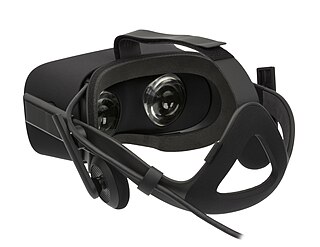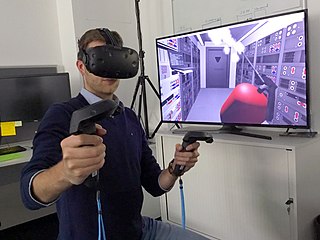A microphone array is any number of microphones operating in tandem. There are many applications:

Augmented reality (AR) is an interactive experience of a real-world environment where the objects that reside in the real-world are "augmented" by computer-generated perceptual information, sometimes across multiple sensory modalities, including visual, auditory, haptic, somatosensory, and olfactory. The overlaid sensory information can be constructive or destructive and is seamlessly interwoven with the physical world such that it is perceived as an immersive aspect of the real environment. In this way, augmented reality alters one's ongoing perception of a real-world environment, whereas virtual reality completely replaces the user's real-world environment with a simulated one. Augmented reality is related to two largely synonymous terms: mixed reality and computer-mediated reality.

A head-related transfer function (HRTF) also sometimes known as the anatomical transfer function (ATF) is a response that characterizes how an ear receives a sound from a point in space. As sound strikes the listener, the size and shape of the head, ears, ear canal, density of the head, size and shape of nasal and oral cavities, all transform the sound and affect how it is perceived, boosting some frequencies and attenuating others. Generally speaking, the HRTF boosts frequencies from 2–5 kHz with a primary resonance of +17 dB at 2,700 Hz. But the response curve is more complex than a single bump, affects a broad frequency spectrum, and varies significantly from person to person.
3D audio effects are a group of sound effects that manipulate the sound produced by stereo speakers, surround-sound speakers, speaker-arrays, or headphones. This frequently involves the virtual placement of sound sources anywhere in three-dimensional space, including behind, above or below the listener.
Sound localization is a listener's ability to identify the location or origin of a detected sound in direction and distance. It may also refer to the methods in acoustical engineering to simulate the placement of an auditory cue in a virtual 3D space.

A virtual retinal display (VRD), also known as a retinal scan display (RSD) or retinal projector (RP), is a display technology that draws a raster display directly onto the retina of the eye. The user sees what appears to be a conventional display floating in space in front of them.
In acoustics, the dummy head recording is a method of recording used to generate binaural recordings. The tracks are then listened to through headphones allowing for the listener to hear from the dummy’s perspective. The dummy head is designed to record multiple sounds at the same time enabling it to be exceptional at recording music as well as in other industries where multiple sound sources are involved.
The Cabinet of Dr. Fritz was a 1984–85 binaural radio drama series produced by Thomas Lopez and the ZBS Foundation for NPR. At the beginning of each show, it was suggested that listeners wear headphones.
Cook Records was a record label founded by Emory Cook (1913–2002), an audio engineer and inventor. From 1952 to 1966, Cook used his Sounds of our Times and Cook Laboratories record labels to demonstrate his philosophy about sound, recording equipment, and manufacturing techniques.
In computing, 3D interaction is a form of human-machine interaction where users are able to move and perform interaction in 3D space. Both human and machine process information where the physical position of elements in the 3D space is relevant.
Ambiophonics is a method in the public domain that employs digital signal processing (DSP) and two loudspeakers directly in front of the listener in order to improve reproduction of stereophonic and 5.1 surround sound for music, movies, and games in home theaters, gaming PCs, workstations, or studio monitoring applications. First implemented using mechanical means in 1986, today a number of hardware and VST plug-in makers offer Ambiophonic DSP. Ambiophonics eliminates crosstalk inherent in the conventional “stereo triangle” speaker placement, and thereby generates a speaker-binaural soundfield that emulates headphone-binaural sound, and creates for the listener improved perception of “reality” of recorded auditory scenes. A second speaker pair can be added in back in order to enable 360° surround sound reproduction. Additional surround speakers may be used for hall ambience, including height, if desired.
In 3D user interaction (3DUI) the human interacts with a computer or other device with an aspect of three-dimensional space. This interaction is created thanks to the interfaces, which will be the intermediaries between human and machine.

A mixing engineer is a person responsible for combining ("mixing") the different sonic elements of a piece of recorded music into a final version of a song. He or she mixes the elements of a recorded piece together to achieve a good balance of volume, while at the same time deciding other properties such as pan positioning, effects, and so on.
Auralization is a procedure designed to model and simulate the experience of acoustic phenomena rendered as a soundfield in a virtualized space. This is useful in configuring the soundscape of architectural structures, concert venues, public-spaces and in making coherent sound environments within virtual immersion systems.
Perceptual-based 3D sound localization is the application of knowledge of the human auditory system to develop 3D sound localization technology.

A virtual reality headset is a head-mounted device that provides virtual reality for the wearer. Virtual reality (VR) headsets are widely used with video games but they are also used in other applications, including simulators and trainers. They comprise a stereoscopic head-mounted display, stereo sound, and head motion tracking sensors. Some VR headsets also have eye tracking sensors and gaming controllers.
3D sound refers to the way humans experience sound in their everyday lives. In real life, people are always surrounded by sound. Sounds arrive at our ears from every direction and from varying distances. These and other factors contribute to the three-dimensional aural image humans hear. Scientists and engineers who work with 3D sound work to accurately synthesize the complexity of real-world sounds.

Positional tracking detects the precise position of the head-mounted displays, controllers, other objects or body parts within Euclidean space. Positional tracking registers the exact position due to recognition of the rotation and recording of the translational movements. Since virtual reality is about emulating and altering reality it’s important that we can track accurately how objects move in real life in order to represent them inside VR. Defining the position and orientation of a real object in space is determined with the help of special sensors or markers. Sensors record the signal from the real object when it moves or is moved and transmit the received information to the computer.






